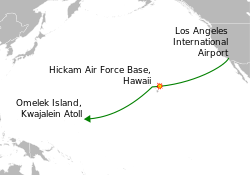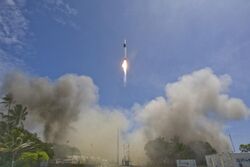RatSat
Topic: Engineering
 From HandWiki - Reading time: 7 min
From HandWiki - Reading time: 7 min
 RatSat, with a SpaceX sticker and its mission logo | |
| Mission type | Launch demonstration |
|---|---|
| Operator | SpaceX |
| COSPAR ID | 2008-048A |
| SATCAT no. | 33393 |
| Mission duration | 15 years, 9 months, 13 days (in orbit) |
| Spacecraft properties | |
| Manufacturer | SpaceX |
| Launch mass | 165 kg (364 lb)[1] |
| Dimensions | 1.5 m (4.9 ft) in length |
| Start of mission | |
| Launch date | 28 September 2008, 23:15 UTC |
| Rocket | Falcon 1 |
| Launch site | Omelek Island |
| Contractor | SpaceX |
| Orbital parameters | |
| Regime | Low Earth orbit |
| Perigee altitude | 617 kilometers (383 mi)[2] |
| Apogee altitude | 635 kilometers (395 mi)[2] |
| Inclination | 9.35°[2] |
| Period | 97.09 minutes[2] |
| Epoch | 24 January 2015, 18:58:23 UTC[2] |
RatSat[1](p184) or DemoSat[3] was an aluminum mass simulator on the fourth flight of the Falcon 1 rocket, launched on 28 September 2008. Ratsat[4] remained bolted to the second stage of the carrier rocket after reaching low Earth orbit.[5] It is an aluminium alloy chamber in hexagonal prism shape with 1.5 m (5 ft) length.[6]
The Falcon 1 launch that carried Ratsat to orbit was the first successful orbital launch of any privately funded and developed, liquid-propellant carrier rocket, the SpaceX Falcon 1, something only six nations had successfully accomplished previously.[7]
The launch, identified as Falcon 1 Flight 4, was conducted by SpaceX, and also marked the first time the Falcon 1 rocket successfully achieved orbit, after three consecutive failures on the three previous launch attempts.[8]
Background
Prior to Ratsat's launch, three consecutive flights of the Falcon 1 rocket had ended in failure. In particular, during the third launch of the Falcon 1 in August 2008, the first stage of the rocket after stage separation exhibited residual thrust and slammed into its second stage, resulting in catastrophic damage to the second stage's Kestrel engine.[1](pp177-179)[8] Though the fix for the problem was simple – add a time delay between main engine cut off and stage separation – SpaceX was running out of money and there was much uncertainty as to whether or not there would be a fourth flight for the company.[1](pp178-179) SpaceX's CEO, Elon Musk, was under immense stress financially and personally, as both of his ventures, SpaceX and Tesla Inc., were at risk of bankruptcy due to a series of failures. Compounding his financial stress was his recent divorce with Justine Musk - the resulting property settlement left him homeless, as well as having lost their first son due to SIDS.[1](pp182-183)
Preparation
Shipping to Omelek
Right after the third launch failure, Musk made an encouraging speech for the SpaceX employees and told them to launch another rocket in six weeks. According to Musk, this tight schedule was necessary or else the company would be in bankruptcy. The rocket was built out of spare parts laying around in the factory.[1](p183)
The fourth launch of the Falcon 1 was supposed to deliver the Malaysian government's RazakSAT satellite, but the Malaysian government has backed out and no other customer was willing to launch on a thrice-failed rocket. Therefore, the SpaceX team had to make a non-functional aluminum boilerplate to simulate the rocket's payload. The boilerplate weighed 165 kg (364 lb) and was named "RatSat" after the last names of Jeff Richichi, Ray Amador and Chris Thompson, who were part of the company's structures team. The design for RatSat's logo was inspired by Ed Roth t-shirts, whom Thompson admired.[1](pp183-184)
Normally, Falcon 1's first stage would have been shipped by container to Omelek Island, Kwajalein Atoll, U.S. (where SpaceX launched the rocket) and Falcon 1's second stage would fly out to the island using the Douglas DC-8 aircraft. The first stage was too big to be flown out using a DC-8. However, the tight schedule mandated the first stage to be shipped over air, so after scrambling with military contacts, a SpaceX employee was able to book a flight on the United States Air Force 's Boeing C-17 Globemaster III with a price of $500,000. Being much larger than the DC-8, the C-17 can easily fit the rocket's first stage (which its dry mass weighs 1,800 kg (4,000 lb) compared to the C-17 carrying capacity of 77,000 kg or 170,000 lb) and twenty supporting employees.[1](pp184-187)

On 3 September, the C-17 landed at the Los Angeles International Airport near SpaceX's headquarters, loaded up, and took off without issues. An intentional small opening in the Falcon 1's oxygen tank fuel pressurization line was made to equalize the rocket's internal pressure with the surroundings. This approach worked well enough for the rocket tanks to slowly release its pressure while the plane was ascending. However, when it was time for the plane to descend to Hawaii and the cabin depressurized, the small opening did not allow air to pass into the rocket tanks fast enough. Thus, the Falcon 1 imploded, right next to the supporting crew. Had SpaceX crews not been onboard the flight, the Falcon 1 would have been ditched into the sea.[1](pp183-189)
With only 30 minutes of fuel left and the rocket continuing to crumble, the crew cut the shrink wraps with their knives and set to work fixing the problem. A member of the crew crawled inside the Falcon 1's interstage with a wrench and detached a pressurization line inside, allowing air to pass inside. The crumbling oxygen tank was inflated back to shape, though it had sustained damages to its structure. The C-17 landed at the Hickam Air Force Base , Hawaii at midnight. The next morning, the crew and rocket took off from Hawaii and landed on an airstrip in the Kwajalein Atoll. A barge then carried the first stage of the rocket to Omelek Island.[1](pp188-192)
Rocket fixes and tests
Using a borescope, a slosh baffle was found detached from the tank body, and it was clear that the Falcon 1 needed a total disassembly. A 'proper' six-weeks long fixing procedure was proposed, but it was promptly rejected because by then, SpaceX would not have any funds and would be bankrupted. Another solution suggesting shipping back the rocket to the headquarters was also not viable for the same reason. The only viable option was to disassemble the rocket on the island itself, within one week. As the engineers were working on the rocket, a crew sen [1](pp192-?)
The Falcon 1 rocket was successfully test-fired on 20 September.[8] Launch preparations on 23 September led the ground crew to replace part of a pipeline supplying liquid oxygen to the second stage Kestrel engine. This work delayed the launch to 28 September.[9]
Launch
The launch occurred from Omelek Island, part of the Kwajalein Atoll in the Marshall Islands.[10] Liftoff occurred at 23:15 UTC on 28 September, 15 minutes into a five-hour launch window. If the launch had been scrubbed, it could have been conducted during the same window until 1 October.[9] Nine minutes and 31 seconds after launch, the second stage engine shut down, after the vehicle reached orbit.[10] The initial orbit was reported to be approximately 330 by 650 kilometres (210 mi × 400 mi).[7] Following a coast period, the second stage restarted, and performed a successful second burn, resulting in a final orbit of 621 by 643 kilometres (386 mi × 400 mi) at 9.35° inclination.[4]
It was Falcon 1's first successful launch, and the first successful orbital launch of any privately funded and developed, liquid-propellant carrier rocket.[7]
The rocket followed the same trajectory as the previous flight, which had failed to place the Trailblazer, NanoSail-D, PRESat and Celestis Explorers spacecraft into orbit. No major changes were made to the rocket, other than increasing the time between first stage burnout and second stage separation. This minor change addressed the failure seen on the previous flight, recontact between the first and second stages, by dissipating residual thrust in the enhanced first stage engine in vacuum before separation.[8][5][11]
Although SpaceX was working on concepts to recover the first stage of Falcon 1, as of this launch, they had not yet succeeded in doing so.[12] Stage recovery was not a primary goal of these early flights. SpaceX utilized an incremental development process to iterate the design issues of booster stage recovery. CEO Elon Musk stated that the probability of a successful recovery would increase with subsequent flights, however the Falcon 1 was subsequently retired from service after its fifth launch, with first stage recovery never having been accomplished successfully. The first stage of the successor rocket, the Falcon 9, would eventually fulfill and prove the viability of booster stage recovery.
See also
- 2008 in spaceflight
References
- ↑ 1.00 1.01 1.02 1.03 1.04 1.05 1.06 1.07 1.08 1.09 1.10 Berger, Eric (March 2, 2021). Liftoff: Elon Musk and the Desperate Early Days That Launched SpaceX. London: William Morrow and Company. ISBN 978-0-00-844562-1. OCLC 1233312066.
- ↑ 2.0 2.1 2.2 2.3 2.4 "DEMOSAT/FALCON 1 Satellite details 2008-048A NORAD 33393". N2YO. 24 January 2015. http://www.n2yo.com/satellite/?s=33393.
- ↑ "DemoSat, NSSDC ID: 2008-048A". NASA NSSDC. 2008-09-28. https://nssdc.gsfc.nasa.gov/nmc/spacecraft/display.action?id=2008-048A.
- ↑ 4.0 4.1 McDowell, Jonathan (2008-09-26). "Issue 601". Jonathan's Space Report. http://host.planet4589.org/space/jsr/back/news.601.
- ↑ 5.0 5.1 Clark, Stephen (2008-09-27). "SpaceX to launch its fourth Falcon 1 rocket on Sunday". Spaceflight Now. http://www.spaceflightnow.com/falcon/004/080927preview.html.
- ↑ "Press Release: SpaceX Successfully Launches Falcon 1 to Orbit". http://www.spacex.com/press.php?page=20080928.
- ↑ 7.0 7.1 7.2 Clark, Stephen (2008-09-28). "Sweet Success at Last for Falcon 1 Rocket". Spaceflight Now. http://www.spaceflightnow.com/falcon/004/index.html. "the first privately developed liquid-fueled rocket to successfully reach orbit."
- ↑ 8.0 8.1 8.2 8.3 Malik, Tariq; Berger, Brian (2008-08-06). "SpaceX Traces Third Rocket Failure to Timing Error". Space.com. http://www.space.com/news/080806-spacex-falcon1-update.html.
- ↑ 9.0 9.1 Musk, Elon (2008-09-27). "Falcon 1 Flight 4". SpaceX. http://www.spacex.com/F1-004.php.
- ↑ 10.0 10.1 Ray, Justin (2008-09-28). "Mission Status Center". Spaceflight Now. http://www.spaceflightnow.com/falcon/004/status.html.
- ↑ Schwartz, John (2008-09-29). "Private Company Launches Its Rocket Into Orbit". The New York Times. ISSN 0362-4331. https://www.nytimes.com/2008/09/29/science/space/29launch.html?_r=1&ref=us&oref=slogin.
- ↑ "Let's celebrate a new era!". SpaceXpla.net. 2008-10-07. http://www.spacexpla.net/blog/?p=79. [|permanent dead link|dead link}}]
Further reading
- Photo section, page i-1 – i-16, at Berger, Eric (March 2, 2021). Liftoff: Elon Musk and the Desperate Early Days That Launched SpaceX. London: William Morrow and Company. ISBN 978-0-00-844562-1. OCLC 1233312066.
 |
 KSF
KSF

